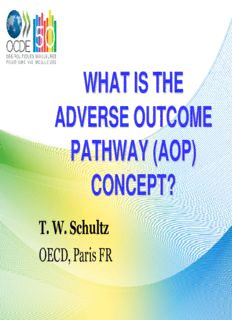
What is the Adverse Outcome Pathway (AOP) PDF
Preview What is the Adverse Outcome Pathway (AOP)
WHAT IS THE ADVERSE OUTCOME PATHWAY (AOP) CONCEPT? T. W. Schultz OECD, Paris FR Discussion Topics Terminology Variables that Control Toxicity The Paradigm Shift Adverse Outcome Pathway Complexity in Toxicity OECD AOP for Skin Sensitisation Development & Assessments of an AOP Best Principles Terminology Source Environmental Exposure Molecular Organelle Cellular Tissue Organ Organ Individual Population Community Containment Initiating and Effects Effects Effects Systems Effects Effects Effects Event Molecular Effects Assemblies Effects Toxicity Pathway Mode of Action Adverse Outcome Pathway Source to Outcome Pathway Adapted from K. Crofton 2010, OECD AOP Meeting Definitions Variables that Control Toxicity Two major variables. The Molecular Initiating Event Matrix (MIEM) A listing of relative binding affinities for all possible “biological receptors” that fall within the structural domain of a chemical. The Response Matrix (RM) A listing of the biological responses and coefficients between the different responses in all the subsystems (e.g. cells, tissues, organ etc.) and, ultimately, the in vivo endpoint of interest (e.g. skin sensitisation). The Molecular Initiating Event Matrix Chemical interactions are at the molecular level. Most chemicals can interact with more than one molecular target. Most chemicals have different affinities for different target. The fasts reaction typically drives the in vivo toxicity. The Response Matrix Can be large, but it is finite. Experience has shown that large portions can be scaled with a setting of 1.0. Includes Molecular Screening and Toxicogenomics endpoints as well as traditional endpoints (e.g. histopathology). The Paradigm Shift Today we base chemical management largely on results from a battery of in vivo tests. In the future we want to manage chemicals based on results from alternative methods (e.g. in silico, in chemico, and in vitro methods. What Must We Do? To move chemical management from an in vivo testing based process to an alternative methods based process: Transparency, Mechanistic plausibility. And allow for hypothesis-based testing, especially with rapid and inexpensive screening methods. How Do We Do This? Integrating knowledge of the relevant chemicals interactions with biological systems (i.e. the molecular initiating events) with knowledge of the relevant biological responses or perturbations leading to the apical (e.g. in vivo) outcome of interest. The Adverse Outcome Pathway Source Environmental Exposure Molecular Organelle Cellular Tissue Organ Organ Individual Population Community Containment Initiating and Effects Effects Effects Systems Effects Effects Effects Event Molecular Effects Assemblies Effects Adverse Outcome Pathway
Description: